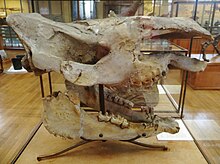Dihoplus
| Dihoplus Temporal range:
| |
|---|---|

| |
| Dihoplus megarhinus skull | |
| Scientific classification | |
| Kingdom: | Animalia |
| Phylum: | Chordata |
| Class: | Mammalia |
| Order: | Perissodactyla |
| Family: | Rhinocerotidae |
| Tribe: | Dicerorhinini |
| Genus: | †Dihoplus Brandt, 1878 |
| Type species | |
| †Dihoplus schleiermacheri Kaup, 1834
| |
| Species | |
| |
Dihoplus is an extinct genus of rhinoceros that lived in Eurasia from the Late Miocene[2] to Early Pleistocene.
They were moderately large rhinoceros, with two horns and large, thick nasal bones.[3] Members of Dihoplus were long placed in Dicerorhinus (which contains the living Sumatran rhinoceros). Sometimes these species are placed in the related Stephanorhinus. The genus is now generally considered distinct,[4] though there is still debate as to which species should be included; for example, Deng (2011) listed Merck's rhinoceros (Stephanorhinus kirchbergensis) under Dihoplus.[5]
References[]
- ^ Pandolfi, Luca; Rivals, Florent; Rabinovich, Rivka (2020). "A new species of rhinoceros from the site of Bethlehem: 'Dihoplus' bethlehemsis sp. nov. (Mammalia, Rhinocerotidae)". Quaternary International. 537: 48–60. doi:10.1016/j.quaint.2020.01.011.
- ^ Pandolfi, Luca; Gasparik, Mihály; Piras, Paolo (2015). "Earliest occurrence of "Dihoplus" megarhinus (Mammalia, Rhinocerotidae) in Europe (Late Miocene, Pannonian Basin, Hungary): Palaeobiogeographical and biochronological implications". Annales de Paléontologie. 101 (4): 325–339. doi:10.1016/j.annpal.2015.09.001.
- ^ Pandolfi, Luca (2013). "New and revised occurrences of Dihoplus megarhinus (Mammalia Rhinocerotidae) in the Pliocene of Italy". Swiss Journal of Palaeontology. 132 (2): 239–255. doi:10.1007/s13358-013-0056-0.
- ^ Tong, Hao-wen (2012). "Evolution of the non-Coelodonta dicerorhine lineage in China". Comptes Rendus Palevol. 11 (8): 555–562. doi:10.1016/j.crpv.2012.06.002.
- ^ Deng, T. (September 2, 2011). "Out of Tibet: Pliocene Woolly Rhino Suggests High-Plateau Origin of Ice Age Megaherbivores". Science.
Categories:
- Miocene rhinoceroses
- Pliocene rhinoceroses
- Pleistocene rhinoceroses
- Miocene mammals of Europe
- Miocene mammals of Asia
- Pliocene mammals of Europe
- Pliocene mammals of Asia
- Pleistocene mammals of Europe
- Pleistocene mammals of Asia
- Prehistoric odd-toed ungulate stubs